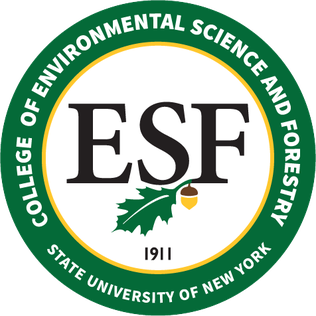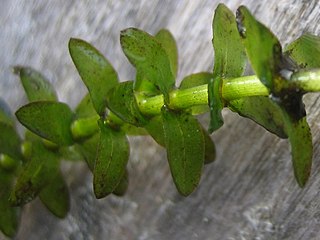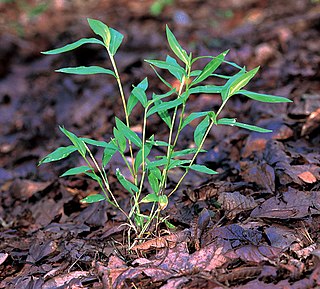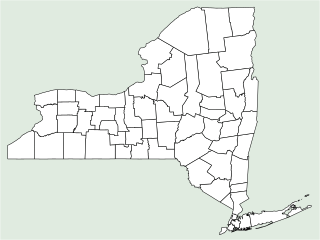Related Research Articles

The Adirondack Mountains are a massif of mountains in Northeastern New York which form a circular dome approximately 160 miles (260 km) wide and covering about 5,000 square miles (13,000 km2). The region contains more than 100 peaks, including Mount Marcy, which is the highest point in New York at 5,344 feet (1,629 m). The Adirondack High Peaks, a traditional list of 46 peaks over 4,000 feet (1,200 m), are popular hiking destinations. There are over 200 named lakes with the number of smaller lakes, ponds, and other bodies of water reaching over 3,000. Among the named lakes around the mountains are Lake George, Lake Placid, and Lake Tear of the Clouds. The region has over 1,200 miles (1,900 km) of river.

The State University of New York College of Environmental Science and Forestry (ESF) is a public research university in Syracuse, New York, focused on the environment and natural resources. It is part of the State University of New York (SUNY) system. ESF is immediately adjacent to Syracuse University, within which it was founded, and with which it maintains a special relationship. It is classified among "R2: Doctoral Universities – High research activity".

The New York State College of Agriculture and Life Sciences at Cornell University is one of Cornell University's four statutory colleges, and is the only agricultural college in the Ivy League. With enrollment of approximately 3,100 undergraduate and 1,000 graduate students, CALS is Cornell's second-largest undergraduate college and the third-largest college of its kind in the United States.

Rubus phoenicolasius is an Asian species of raspberry in the rose family, native to China, Japan, and Korea.

Elodea is a genus of eight species of aquatic plants often called the waterweeds described as a genus in 1803. Classified in the frog's-bit family (Hydrocharitaceae), Elodea is native to the Americas and is also widely used as aquarium vegetation and laboratory demonstrations of cellular activities. It lives in fresh water. An older name for this genus is Anacharis, which serves as a common name in North America.

Hydrilla (waterthyme) is a genus of aquatic plant, usually treated as containing just one species, Hydrilla verticillata, though some botanists divide it into several species. It is native to the cool and warm waters of the Old World in Asia, Africa and Australia, with a sparse, scattered distribution; in Australia from Northern Territory, Queensland, and New South Wales.

Algonquin Peak is a mountain in the MacIntyre Range of the Adirondacks in the U.S. state of New York. It is the second-highest mountain in New York, with an elevation of 5,114 feet (1,559 m), and one of the 46 Adirondack High Peaks. It is located in the town of North Elba in Essex County and in the High Peaks Wilderness Area of Adirondack Park. The first recorded ascent of the mountain was made on August 8, 1837, by a party led by New York state geologist Ebenezer Emmons. It was originally named Mount McIntyre, after Archibald McIntyre, but this name was eventually applied to the entire range. Surveyor Verplanck Colvin added the name "Algonquin" in 1880. This name came from the peak reputedly being on the Algonquian side of a nearby informal boundary between the Algonquian and their Iroquois neighbors, although no such boundary existed in reality.

Berberis thunbergii, the Japanese barberry, Thunberg's barberry, or red barberry, is a species of flowering plant in the barberry family Berberidaceae, native to Japan and eastern Asia, though widely naturalized in China and North America, where it has become a problematic invasive in many places, leading to declines in species diversity, increased tick habitat, and soil changes. Growing to 1 m tall by 2.5 m broad, it is a small deciduous shrub with green leaves turning red in the autumn, brilliant red fruits in autumn and pale yellow flowers in spring.

Myriophyllum spicatum is a submerged aquatic plant which grows in still or slow-moving water. It is native to Europe, Asia, and North Africa, but has a wide geographic and climatic distribution among some 57 countries, extending from northern Canada to South Africa. It is considered to be a highly invasive species.

The New York State Department of Environmental Conservation is a department of New York state government. The department guides and regulates the conservation, improvement, and protection of New York's natural resources; manages Forest Preserve lands in the Adirondack and Catskill parks, state forest lands, and wildlife management areas; regulates sport fishing, hunting and trapping; and enforces the state's environmental laws and regulations. Its regulations are compiled in Title 6 of the New York Codes, Rules and Regulations. It was founded in 1970, replacing the Conservation Department, and is headed by Basil Seggos.

Microstegium vimineum, commonly known as Japanese stiltgrass, packing grass, or Nepalese browntop, is an annual grass that is common in a wide variety of habitats and is well adapted to low light levels. It has become an invasive species throughout parts of the world, most notably North America.
The New York State College of Forestry at Cornell was a statutory college established in 1898 at Cornell University to teach scientific forestry. The first four-year college of forestry in the country, it was defunded by the State of New York in 1903, over controversies involving the college's forestry practices in the Adirondacks. Forestry studies continued at Cornell even after the college's closing.

Invasive species are a crucial threat to many native habitats and species of the United States and a significant cost to agriculture, forestry, and recreation. An invasive species refers to an organism that is not native to a specific region and poses significant economic and environmental threats to its new habitat. The term "invasive species" can also refer to feral species or introduced diseases. Some introduced species, such as the dandelion, do not cause significant economic or ecologic damage and are not widely considered as invasive. Economic damages associated with invasive species' effects and control costs are estimated at $120 billion per year.
Westchester County, New York is located in southern New York, sharing its southern boundary with New York City and its northern border with Putnam County. It is bordered on the west side by the Hudson River and on the east side by the Long Island Sound and Fairfield County, Connecticut. The county has a total area of 500 square miles, of which 430 square miles is land and 69 square miles (14%) is water. It is an area rich in biodiversity with many parks and preserves. Literary environmental writer Alex Shoumatoff hailed Westchester County as the "most richly diversified deciduous forest in the world" in a 1978 The New Yorker profile, at the time estimating that it contained 4,200 species of plants.

Environmental issues in New York State include water, waste disposal, hydraulic fracturing, air quality, and invasive species.
Agriculture is a major component of the New York economy. As of the 2012 census of agriculture, there were over 35,000 farms covering an area of 7 million acres (28,000 km2) which contributed $5.4 billion in gross sales value and $1.2 billion in net farm income to the national economy. Dairy farming alone accounted for $2.5 billion or 45% of sales. The Finger Lakes region is the center of state agriculture, and the state is a top-ten national producer of cow milk, apples, grapes, onions, sweet corn, tomatoes, and maple syrup. New York places second in apple production after Washington.

Cayuga Inlet is a river located in Tompkins County, New York. It flows into the south end of Cayuga Lake by Ithaca, New York.

Silver Lake is a lake located in Clinton County, New York in the Adirondack Park. Silver Lake Mountain and the hamlet of Hawkeye, New York are located on the northeast shores of the lake.The lake was created thousands of years ago, due to the dissolution of glaciers in the Western area of New York. The northern and eastern shores of the lake contain many private camps, while the southern and western shores are forever wild.

Osgood Pond is a five hundred acre lake in the hamlet of Paul Smiths, Town of Brighton, Franklin County, New York. It is the site of White Pine Camp, the Summer White House of President Calvin Coolidge, and of the historic Northbrook Lodge, listed on the National Register of Historic Places in 2014. Both were built by Benjamin A. Muncil.
References
- ↑ "New York State Prohibited and Regulated Invasive Plants" (PDF). New York Department of Environmental Conservation. September 10, 2014. Retrieved October 14, 2019.
- ↑ "NY Invasive Species (IS) Info". Cornell Cooperative Extension and NY Sea Grant. Retrieved October 14, 2019.
- ↑ "Invasive Plants". New York Botanical Gardens. Retrieved October 14, 2019.
- ↑ Ben Axelson (2018-07-16). "15 invasive plants that could be wreaking havoc on your yard or garden in Upstate NY". NYUP.com. Retrieved October 14, 2019.
- ↑ Michelle Sutton. "Governor Cuomo Announces $2.8 Million in Grant Awards to Combat Spread Of Invasive Species". New York State Urban Forestry Council. Retrieved November 1, 2019.
- ↑ "Invasive Species". Cornell Cooperative, Dutchess County. Retrieved October 14, 2019.
- ↑ "Lower Hudson PRISM" . Retrieved November 1, 2019.
- ↑ "Partnerships for Regional Invasive Species Management (PRISM)". NYDEC. Retrieved November 2, 2019.
- ↑ "Norway Maple". Cornell Cooperative Extension and NY Sea Grant. Retrieved October 14, 2019.
- ↑ "Norway Maple". Adirondack Park Invasive Plant Program. Retrieved November 1, 2019.
- ↑ "Tree of Heaven". Adirondack Park Invasive Plant Program. Retrieved November 1, 2019.
- ↑ "Tree of Heaven: An Exotic Invasive Plant Fact Sheet" . Retrieved November 1, 2019.
- ↑ "Garlic Mustard". Adirondack Park Invasive Plant Program. Retrieved November 1, 2019.
- ↑ "Japanese angelica tree". Lower Hudson PRISM. Retrieved October 14, 2019.
- ↑ "Japanese Angelica Tree". Adirondack Park Invasive Plant Program. Retrieved November 2, 2019.
- ↑ "Japanese Barberry". Adirondack Park Invasive Plant Program. Retrieved November 1, 2019.
- ↑ "Asian Bittersweet". Adirondack Park Invasive Plant Program. Retrieved November 1, 2019.
- ↑ "Oriental bittersweet". LHPRISM. Retrieved November 2, 2019.
- ↑ "Autumn Olive". Adirondack Park Invasive Plant Program. Retrieved November 1, 2019.
- ↑ "Burning Bush". Martha's Vineyard, Massachusetts: Vineyard Gazette. Retrieved November 1, 2019.
- ↑ Max Oppen. "11 Invasive Species Wreaking Havoc on NY". Environmental Advocates of New York. Retrieved October 14, 2019.
- ↑ "Japanese Knotweed". Adirondack Park Invasive Plant Program. Retrieved November 1, 2019.
- ↑ "Bush Honeysuckles". Adirondack Park Invasive Plant Program. Retrieved November 1, 2019.
- ↑ "Purple Loosestrife". Adirondack Park Invasive Plant Program. Retrieved November 1, 2019.
- ↑ "Japanese Stiltgrass". Adirondack Park Invasive Plant Program. Retrieved November 2, 2019.
- ↑ "Japanese Stiltgrass". Cornell Cooperative Extension and NY Sea Grant. Retrieved November 2, 2019.
- ↑ "Mile-A-Minute". Cornell Cooperative Extension and NY Sea Grant. Retrieved November 3, 2019.
- ↑ "Adirondack PRISM: Invasive and Non-Native Plants" (PDF). Adirondack PRISM. Retrieved November 2, 2019.
- ↑ "Common Reed". Cornell Cooperative Extension and NY Sea Grant. Retrieved November 2, 2019.
- ↑ "Lesser Celadine". Adirondack Park Invasive Plant Program. Retrieved November 1, 2019.
- ↑ "NEW YORK NON-NATIVE PLANT INVASIVENESS RANKING FORM-Jetbead" (PDF). USDA. Retrieved October 14, 2019.
- ↑ "Multiflora Rose". Adirondack Park Invasive Plant Program. Retrieved November 1, 2019.
- ↑ "Wineberry". Cornell Cooperative Extension and NY Sea Grant. Retrieved October 14, 2019.
- ↑ "Wineberry". Cornell Cooperative Extension and NY Sea Grant. Retrieved November 2, 2019.
- ↑ "Porcelain Berry". Adirondack Park Invasive Plant Program. Retrieved November 2, 2019.
- ↑ "Adirondack PRISM: Invasive and Non-Native Plants" (PDF). Adirondack PRISM. Retrieved November 2, 2019.
- ↑ "Adirondack PRISM: Invasive and Non-Native Plants" (PDF). Adirondack PRISM. Retrieved November 2, 2019.
- ↑ "Hydrilla". Cornell Cooperative Extension Tompkins County. Retrieved November 2, 2019.
- ↑ "Hydrilla". NEW YORK INVASIVE SPECIES (IS) INFORMATION. Retrieved November 2, 2019.
- ↑ "Water Chestnut". Cornell Cooperative Extension and NY Sea Grant. Retrieved November 2, 2019.